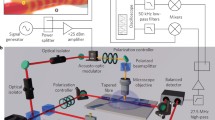Abstract
Optical biosensors, based on evanescent wave technology, are analytical devices that measure the interactions between biomolecules in real time, without the need for any labels. Specific ligands are immobilized to a sensor surface, and a solution of receptor or antibody is injected over the top. Binding is measured by recording changes in the refractive index, caused by the molecules interacting near the sensor surface within the evanescent field. Evanescent wave-based biosensors are being used to study an increasing number of applications in the life sciences, including the binding and dissociation kinetics of antibodies and receptor-ligand pairs, protein-DNA and DNA-DNA interactions, epitope mapping, phage display libraries, and whole cell- and virus-protein interactions. There are currently four commercially available avanescent wave biosensors on the market. This article describes the technology behind their sensing techniques, as well as the range of applications in which they are employed.
Similar content being viewed by others
References
Scheller, F., Schubert, F., Pfeiffer, D., Hintsche, R., Dransfeld, I., Renneberg, R., Wollenberger, U., Riedel, K., Pavlova, M., Kuhn, M., and Muller, H.-G. (1989) Research and development of biosensors. A review.Analyst 114(6), 653–62.
Thompson, M. and Krull, U. J. (1991) Biosensors and the transduction of molecular recognition.Anal. Chem. 63(7), 393A-405A.
Schultz, J. S. (1991) Biosensors.Sci. Am. 265(2), 64–69.
Roe, J. N. (1992) Biosensor development.Pharm. Res. 9(7), 835–844.
Vadgama, P. and Crump, P. W. (1992) Biosensors: Recent trends.Analyst 117, 1657–1670.
Liedberg, B., Nylander, C., and Lundstrom, I. (1983) Surface plasmon resonance for gas-detection and biosensing.Sensor Actuators 4, 299–304.
Fägerstam, L. G. (1991) A non-label technology for real-time biospecific interaction analysis.Techniques in Protein Chemistry II (Villafranca, J., ed.), Academic, New York, pp. 65–71.
Jönsson, U., Fägerstam, L., Ivarsson, B., Johnsson, B., Karlsson, R., Lundh, K., Löfås, S., Persson, B., Roos, H., Rönnberg I., Sjölander, S., Stenberg, E., Ståhlberg, R., Urbaniczky, C., Östlin, H., and Malmqvist, M. (1991) Real-time biospecific interaction analysis using surface plasmon resonance and a sensor chip technology.BioTechniques 11(5), 620–627.
Stenberg, E., Persson, B., Roos, H., and Urbaniczky, C. (1991) Quantitative determination of surface concentration of protein with surface plasmon resonance using radiolabeled proteins.J. Colloid Interface Sci. 143, 513–526.
Cush, R., Cronin, J. M., Stewart, W. J., Maule, C. H., Molloy, J., and Goddard, N. J. (1993) The resonant mirror: A novel optical biosensor for direct sensing of biomolecular interactions. Part I: Principle of operation and associated instrumentation.Biosensors Bioelectronics 8, 347–353.
Lukosz, W., Clerc, D., Nellen, P. M., Stamm, C., and Weiss, P. (1991) Output grating couplers on planar optical waveguides as direct immunosensors.Biosensors Bioelectronics 6(3), 227–232.
Karlsson, R., Michaelsson, A., and Mattsson, L. (1991) Kinetic analysis of monoclonal antibody-antigen interactions with a new biosensor based analytical system.J. Immunol. Methods 145, 229–240.
Fägerstam, L. G., Frostell, A., Karlsson, R., Kullman, M., Larsson, A., Malmqvist, M., and Butt, H. (1990) Detection of antigen-antibody interactions by surface plasmon resonance. Application to epitope mapping.J. Mol. Recognition 3(5/6), 208–214.
Johne, B., Gadnell, M., and Hansen, K. (1993) Epitope mapping and binding kinetics of monoclonal antibodies using real time biospecific interaction using surface plasmon resonance.J. Immunol. Methods 160(2), 191–198.
Söderlind, E., Simonsson, A. C., and Borrebaeck, C. A. K. (1992) Phage display technology in antibody engineering: Design of phagemid vectors andin vitro maturation systems.Immunol. Rev. 130, 503–507.
Holliger, P., Prospero, T., and Winter, G. (1993) “Diabodies”: Small bivalent and bispecific antibody fragments.Proc. Natl. Acad. Sci. 90, 6444–6448.
Cunningham, B. C. and Wells, J. A. (1993) Comparison of a structural and functional epitope.J. Mol. Biol. 234, 554–563.
Brigham-Burke, M. and O'Shannessy, D. J. (1993) A micro-scale method employing surface plasmon resonance for the determination of conditions for immunoaffinity chromatography of proteins.Chromatographia 35(1/2), 45–49.
O'Brien, D. P., Kemball-Cook, G., Hutchinson, A. M., Martin, D. M., Johnson, D. J., Takamiya, O., Tuddenham, E. G. D., and McVey, J. H. (1994) Surface plasmon resonance studies of the interaction between factor VII and tissue factor. Demonstration of defective tissue factor binding in a variant FVII molecule (FVII-R79Q).Biochemistry 33, 14,162–14,169.
End, P., Gout, I., Fry, M. J., Panayotou, G., Dhand, R., Yonezawa, K., Kasuga, M., and Waterfield, M. D. (1993) A biosensor approach to probe the structure and function of the p85α subunit of the phosphatidylinositol 3-kinase complex.J. Biol. Chem. 268(14), 10,066–10,075.
Felder, S., Zhou, M., Hu, P., Urena, J., Ullrich, A., Chaudhuri, M., White, M., Shoelson, S. E., and Schlessinger, J. (1993) SH2 domains exhibit high affinity binding to tyrosine-phosphorylated peptides yet also exhibit rapid dissociation and exchange.Mol. Cell. Biol. 13(3), 1449–1455.
Schuster, J. S., Swanson, R. V., Alex, L. A., Bourret, R. B., and Simon, M. I. (1993) Assembly and function of a quaternary signal transduction complex monitored by surface plasmon resonance.Nature 365, 343–346.
van der Merwe, P. A., Brown, M., Davis, S. J., and Barclay, A. N. (1993) Affinity and kinetic analysis of the interaction of the cell adhesion molecules rat CD2 and CD48.EMBO J. 12(13), 4945–4954.
Wood, S. J. (1993) DNA-DNA hybridization in real time using BIAcore.Microchem. J. 47, 330–337.
Fisher, R. J., Fivash, M., Casas-Finet, J., Erickson, J. W., Kondoh, A., Bladen, S. V., Fisher, C., Watson, D. K., and Papas, T. (1994) Real time DNA binding measurements of the ETS1 recombinant oncoproteins reveal significant kinetic differences between the p42 and p51 isoforms.Protein Sci. 3, 257–266.
Hutchinson, A. M. (1994) Characterisation of glycoprotein oligosaccharides using surface plasmon resonance.Anal. Biochem. 220, 303–307.
Shinohara, Y., Kim, F., Shimizu, M., Goto, M., Tosu, M., and Hasegawa, Y. (1994) Kinetic measurement of the interaction between an oligosaccharide and lectins by a biosensor based on surface plasmon resonance.Eur. J. Biochem. 223, 189–194.
Dubs, M-C., Altschuh, D., and van Regenmortel, M. (1991) Interaction between viruses and monoclonal antibodies studied by surface plasmon resonance.Immunol. Lett. 31, 59–64.
Brigham-Burke, M., Edwards, J. R., and O'Shannessy, D. J. (1992) Detection of receptor-ligand interactions using surface plasmon resonance: Model studies employing the HIV-1 gp120/CD4 interaction.Anal. Biochem. 205(1), 125–131.
Author information
Authors and Affiliations
Rights and permissions
About this article
Cite this article
Hutchinson, A.M. Evanescent wave biosensors. Mol Biotechnol 3, 47–54 (1995). https://doi.org/10.1007/BF02821334
Issue Date:
DOI: https://doi.org/10.1007/BF02821334



